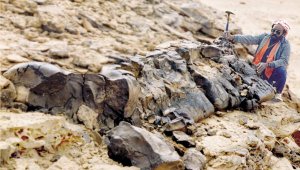Giant Fungus and Fossil Detectives
Science Daily ran an interesting summary about researchers verifying the identity of a giant organism found in the Devonian. I’ve always had a soft spot for the Devonian since the rocks in my hometown in Michigan are all from that period so I thought I’d take a look. Even without the childhood memories of brachiopods and trilobites, the Devonian is a pretty cool period in time from about 410 to 360 million years. In the ocean, nautilus-like ammonites flourished while the first bony fish and sharks evolved and radiated. On land, the Devonian started empty with only bacterial and algal mats covering the ground. By the end of the Devonian, forests of ferns and trees populated by insects and other arthropods were flourishing while our tetrapod ancestors took their first steps on to land. Between these two extremes of lush forests and barren ground, an organism whose identity remained unknown for a hundred years after it’s discovery developed and towered over the landscape.

The first scientist, J. W. Dawson, to describe these fossil “logs” (like the picture to the left) thought they were palm tree-like plants and classified them as ancestors of conifers Prototaxites (Taxus is a genus of conifers). When Dawson presented his work in 1870, another scientist attacked it saying that the organism must be a form of giant algae and tried to illegitimately rename the genus. Dawson defended his decision for a while and then silently about-faced, renamed the genus (also illegitimately) and said he had never meant that to imply a relation to conifers. Although there were some suggestions for other classifications, the genus remained largely identified as an algae until 2001 when Hueber published a definitive 36 page paper on the subject.
Continue Reading »